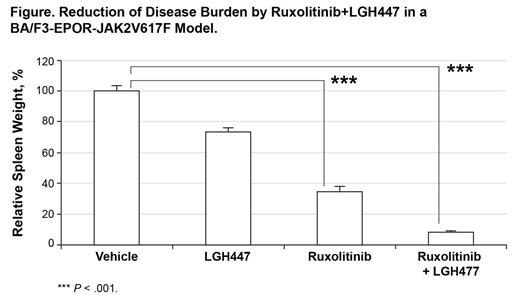Abstract
The JAK-STAT pathway is an important signaling pathway downstream of multiple cytokine and growth factor receptors. It has been implicated in the pathogenesis of multiple human diseases. The genetic aberration of JAK2V617F and the associated activation of STAT in myeloproliferative neoplasia (MPN) is one example of the involvement of this pathway in human cancer. Activated JAKs phosphorylate STAT proteins, which then dimerize and translocate to the nucleus. Inside the nucleus, activated STATs modulate the expression of target genes, including PIM1. PIM kinases are involved in the regulation of cell cycle and proliferation. Recent studies have suggested that PIM1 is one of the key signature genes for STAT5 activation. Based on the biological rationale, we set out to test the combination of the JAK inhibitor, ruxolitinib, and the PIM inhibitor, LGH447, in MPN preclinical models.
The combination of ruxolitinib and LGH447 was tested in vitro against MPN cell lines harboring JAK2V617F mutations. In vitro synergy was observed with the combination of ruxolitinib and LGH447 in UKE-1 and SET2 models. Pharmacodynamic analysis indicates potent modulation of PIM1/2 and pSTAT3/5 by LGH447 and ruxolitinib, respectively. Both agents inhibited pERK and pS6 in UKE-1. The combination achieved greater suppression on these two signaling pathways. In addition, the combination further inhibited pBAD and MCL-1 expression, with the corresponding increase of cleaved PARP. This combination was further tested in a mouse MPN model with BA/F3 cells harboring EPOR-JAK2V617F. Ruxolitinib monotherapy down-modulated overall disease burden and reduced spleen weight. It also inhibited pSTAT5 and pMEK in this model. LGH447 monotherapy had a more modest effect on MPN disease burden. The combination of ruxolitinib and LGH447 resulted in much greater reduction of overall disease burden and spleen weight than either agent alone (Figure). The combination also normalized hemoglobin levels and red blood cell counts in this model.
This finding suggests potential benefit with the combination of ruxolitinib and LGH447 in MPN. By targeting two critical signaling molecules in the JAK/STAT axis, this combination may achieve greater target modulation across key oncogenic pathways, such as MAPK and TOR. This may enable us to achieve greater benefit against MPN in the clinic.
Saci:Novartis: Employment, Equity Ownership. Pinzon-Ortiz:Novartis Institutes for BioMedical Research, Inc.: Employment. Wang:Novartis: Employment. Rong:Novartis: Employment. Growney:Novartis: Employment, Equity Ownership. Squier:Novartis Pharmaceuticals Corp.: Employment. Radimerski:Novartis Pharma AG: Employment, Equity Ownership. Vanasse:Novartis Institutes of BioMedical Research: Employment. Caponigro:Novartis: Employment, Equity Ownership. Garcia:Novartis: Employment, Equity Ownership. Cao:Novartis: Employment, Equity Ownership.
Author notes
Asterisk with author names denotes non-ASH members.


